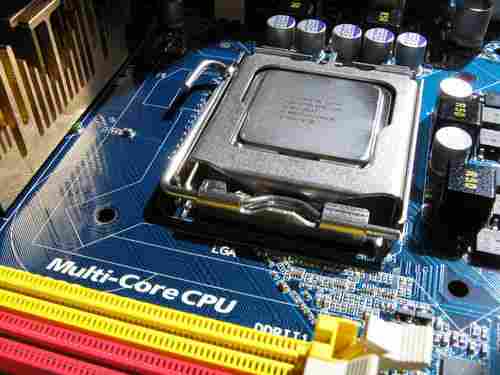
The most vital component of the computer is the motherboard that houses the crucial components of the system. Chipset is the core of the motherboard and is the prime determinant factor in the choice of the processor, and the RAM type etc. Thus, the choice of the right motherboard is of great importance. Firstly, this should be compatible with other components of the PC, especially with the processor, because a high end processor will never perform well with an old motherboard. It is always better to choose the CPU first, and using the same manufacturer for the processor and the chipset can be helpful. Intel and AMD are two primary manufacturers in this category. Other factors like the scalability of the connectors, the integrated devices like the graphics card and most importantly, the likely usage purpose for the PC, should determine the choice of this hardware component.
The motherboard is the basic component of the computer. The choice of motherboard will affect the choice of processor, the type of memory (RAM) and extension ports among other things.
The fundamental component of the motherboard is the chipset. It determines which CPU can work on this motherboard and also the type of RAM (DDR2, DDR3 or DDR2 / DDR3)
To choose a motherboard, you must consider two main points:
Compatibility with other components of the PC: To be perfectly compatible, they should be part of the same generation, and sometimes even from the same manufacturer. A new generation processor will not run on a motherboard too old, even with a BIOS update.
Scalability of the connection: To assemble a computer capable of evolving with future technological progress, the scalability of the connector of your motherboard is crucial. It must support any new hardware you ant to install.You should also consider how you will be using the PC as this will affect your decision too.
Without harmony between these two elements, you will not get good performance. Do not invest in a high performance processor (quad-core type) if your motherboard (and especially its chipset) is unable to accommodate it. It is advisable to choose a motherboard chipset with the same brand as your processor, but this is not essential. Some brands however, such as AMD and Intel are not compatible with one another, so be careful when choosing your brands.
Onceyou have chosen the CPU, you need to choose a chipset.
If you opt for an Intel CPU, you will probably want a motherboard with an Intel or an nVidia chipset.
If you choose an AMD CPU, the chipset should be either AMD or nVidia. Bear this in mind when choosing.
You should be aware of which items are to connect to the motherboard. On a motherboard, you must find USB 2.0 connectors in sufficient numbers, but also an e-SATA port to connect to hot external hard drive, and a FireWire port for digital video.
You should check the number of ports and connectors to make sure that you can connect all the components you need. If you want to upgrade your computer, ports must be available.
These are increasingly common in modern motherboards, but built in graphics cards are rarely of a high enough standard for serious gamers. Similarly, users wanting high sound quality would want to upgrade the built in sound card.
Mae sure you also consider the size of the motherboard. The ATX format is the most common and currently compatible with nearly all configurations. Smaller sizes are available for mini-PCs.
The type and quantity of memory is important too. Not all motherboards accepts all types of RAM, so make sure you check that the type you are buying is compatible first.
The three major manufacturers of motherboards are Asus, Gigabyte and MSI,but there are some other, such as Abit and Foxconn.
Most boards have run with DDR2 since early 2009. DDR3 still costs significantly more for a negligible gain in performance.
DDR3 is currently more suited to high-end users because of the higher bandwidth.











